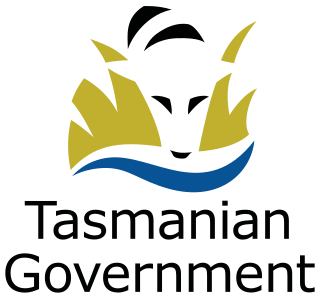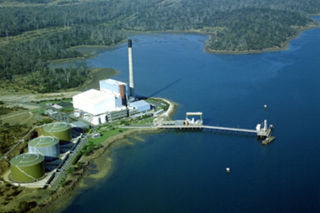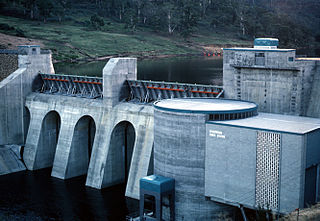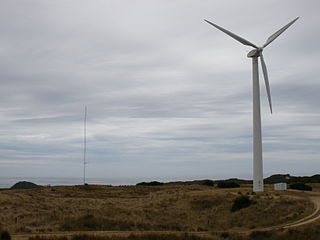| Company type | Electricity generation |
|---|---|
| Industry | Utilities |
| Founded | 2005 |
| Headquarters | Australia |
Area served | Oceania |
Key people | Mark Kelleher (managing director) |
| Products | Electricity |
| Parent | Hydro Tasmania China Light and Power |
| Website | www.roaring40s.com.au |
Roaring 40s was an electricity generator formed in 2005 as a joint venture between Hydro Tasmania, Australia and Hong Kong-based China Light & Power (CLP). [1] [2]
Roaring 40s had 13 sites in operation or in planning in Australia, India, Hong Kong and mainland China. [3] Cathedral Rocks, Woolnorth, Waterloo Wind Farm and Musselroe are four notable power plants that the company owned. [4] Roaring 40s split in June 2011 with the projects being divided between the two original partners, CLP and Hydro Tasmania.

CLP Group and its holding company, CLP Holdings Ltd, also known as China Light and Power Company, Limited, is an electricity company in Hong Kong. Incorporated in 1901 as China Light & Power Company Syndicate, its core business remains the generation, transmission, and retailing of electricity. It also has businesses in a number of Asian markets as well as EnergyAustralia in Australia. It is one of the two main electricity power generation companies in Hong Kong, the other being Hongkong Electric Company.

Hydro Tasmania, known for most of its history as the Hydro-Electric Commission (HEC) or The Hydro, is the trading name of the Hydro-Electric Corporation, a Tasmanian Government business enterprise which is the predominant electricity generator in the state of Tasmania, Australia. The Hydro was originally oriented towards hydro-electricity, due to Tasmania's dramatic topography and relatively high rainfall in the central and western parts of the state. Today Hydro Tasmania operates thirty hydro-electric and one gas power station, and is a joint owner in three wind farms.

The Tasmanian Government or the Government of Tasmania is the executive branch of the Australian state of Tasmania. The leader of the party or coalition with the confidence of the House of Assembly, the lower house of the Parliament of Tasmania, is invited by the governor of Tasmania to form the executive. The governor appoints the premier of Tasmania.

The Bell Bay Power Station was a power station located in Bell Bay, on the Tamar River, Tasmania, Australia, adjacent to the Tamar Valley Power Station, with which it was often confused. It was commissioned between 1971 and 1974 as an oil fired thermal power station, and was converted to natural gas in 2003, after the commissioning of the Tasmanian Gas Pipeline, a submarine gas pipeline which transports natural gas from Longford, Victoria, under Bass Strait, to Bell Bay, Tasmania. As the power station's primary role was to provide system security in the event of drought for Tasmania's predominantly hydro-electric based generation system it only was rarely called on to operate, resulting in intervals of five to eight years between periods of significant use. After the commissioning of Basslink in 2006, the power station was decommissioned in 2009.

The Van Diemen's Land Company is a farming corporation in the Australian state of Tasmania. It was founded in 1825 and received a royal charter the same year, and was granted 250,000 acres (1,000 km2) in northwest Van Diemen's Land in 1826. The company was a group of London merchants who planned a wool growing venture to supply the needs of the British textile industry.

The Meadowbank Power Station is a run-of-the-river hydroelectric power station located in the Central Highlands region of Tasmania, Australia. The power station is situated on the Lower River Derwent catchment and is owned and operated by Hydro Tasmania.
The Rowallan Power Station is a conventional hydroelectric power station located in north-western Tasmania, Australia. The station is located 25 kilometres (16 mi) south of Liena.
Cathedral Rocks Wind Farm is a wind power station located about 30 km west of Port Lincoln in South Australia, near the southern tip of the Eyre Peninsula. It has 33 wind turbines of 2 MW each, with a combined generating capacity of 66 MW of electricity. The site covers an area of about 29 km2, with a coastal exposure of nearly 11 km and is private farming land. The wind farm was commissioned in September 2005.

Huxley Hill Wind Farm is a wind power station at King Island, Tasmania, Australia, of around 1600 residents, owned by Hydro Tasmania, which supplements the four diesel generators with a combined capacity of 6 MW at Currie Power Station. King Island also has a 100 kW solar capacity provided with monocrystaline solar panels on dual-axis arrays.

Renewable energy in Australia is mainly based on biomass, solar, wind, and hydro generation. Over a third of electricity is generated from renewables, and is increasing, with a target to phase out coal power before 2040. Wind energy and rooftop solar have particularly grown since 2010. The growth has been stimulated by government energy policy in order to limit the rate of climate change in Australia that has been brought about by the use of fossil fuels. Pros and cons of various types of renewable energy are being investigated, and more recently there have been trials of green hydrogen and wave power.
Musselroe Wind Farm is a wind farm at Cape Portland, Tasmania, Australia. It was the third wind farm built in the state, following the Bluff Point and Studland Bay Wind Farms.
Tamar Valley Power Station is a $230 million natural gas-fired power station located in Bell Bay in the Tamar Valley, Tasmania. It is owned by Hydro Tasmania, and is immediately adjacent to the decommissioned Bell Bay Power Station, which is also owned by Hydro Tasmania.

The major industries of Tasmania, have been: mining, agriculture, aquaculture, fishing, forestry; and tourism. Mining has including copper, zinc, tin, iron and gold. Food production has included salmon, beef, chicken, pork, dairy and lamb farming, as well as a variety of fruits and vegetables. Apples, pears, strawberries, raspberries, carrots and many varieties of potatoes are produced. Tasmania is known for its wild abalone and crayfish. The crayfish in the local waters, are one of the largest species of rock lobsters in the world, and fetches top prices in northern Pacific market.
Concord New Energy Group Limited is an investment holding company and is listed on the Hong Kong stock exchange with its Hong Kong headquarters at Admiralty, Hong Kong. The company had a management office in Beijing. The Company and its subsidiaries are engaged in engineering, procurement and construction (EPC), operation and maintenance of wind power plants, the manufacture of wind power equipment and other wind power related business. The listed company and its predecessor, had a few former names: Nam Pei Hong (Holding) Limited, Nam Pei Hong International Holdings Limited, N P H International Holdings Limited, Hong Kong Pharmaceutical Holdings Limited and most recently China Windpower Group Limited.
The Basslink electricity interconnector is a 370 km (230 mi) 500 MW (670,000 hp) high-voltage direct current (HVDC) cable linking the electricity grids of the states of Victoria and Tasmania in Australia, crossing Bass Strait, connecting the Loy Yang Power Station, Victoria on the Australian mainland to the George Town substation in northern Tasmania. Basslink is bidirectional and enables Hydro Tasmania to supply some of the peak load capacity to the Australian mainland and take some of the excess power from the mainland when the generation on the mainland exceeds the demand.
Granville Harbour is a rural locality in the local government area (LGA) of West Coast in the North-west and west LGA region of Tasmania. The locality is about 35 kilometres (22 mi) north-west of the town of Zeehan. The 2016 census has a population of 27 for the state suburb of Granville Harbour.

Energy in Hong Kong refers to the type of energy and its related infrastructure used in Hong Kong. Energy is crucial for the development of trade and industries in Hong Kong with its relatively small usable land. Hong Kong mostly imports its energy from outside or produces it through some intermediate process.
The Department of State Growth is the Tasmanian Government department with responsibility for driving state growth.
The 2016 Tasmanian energy crisis was an ongoing energy storage situation in the state of Tasmania, Australia in 2016. Two years of high volumes of energy exported to Victoria via the Basslink HVDC cable, followed by low rainfall, and a fault which rendered the cable inoperable, resulted in record low storage levels in Tasmania's hydro-electric system. This resulted in a number of contingency plans to be enacted by Hydro Tasmania and the Hodgman Government.
Tasmania, as an advanced economy with a globally high standard of living, uses a great deal of energy. Distinctive features of energy use in Tasmania include the high fraction of hydroelectricity usage, the absence of coal-fired electrical generation, relatively light usage of natural gas, particularly for domestic use, and a wide use of domestic wood-burning stoves. Energy production through hydroelectricity has been politically contentious, and conflicts over Tasmanian hydroelectric projects were integral to the formation of Green parties in Australia and across the world.
{{citation}}: CS1 maint: numeric names: authors list (link)